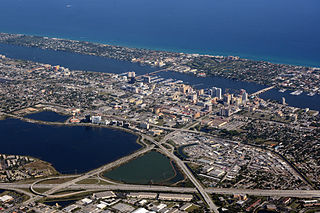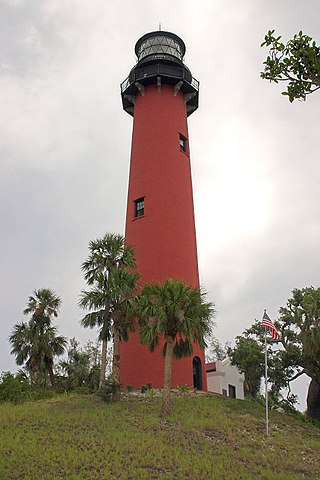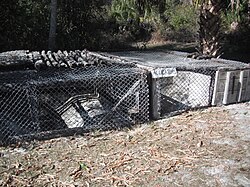
Martin County is a county located in the southeastern part of the state of Florida, in the United States. As of the 2020 census, the population was 158,431. Its county seat is Stuart. Martin County is in the Port St. Lucie, FL Metropolitan Statistical Area.

Palm Beach County is a county in the southeastern part of Florida, located in the Miami metropolitan area. It is Florida's third-most populous county after Miami-Dade County and Broward County and the 26th-most populous in the United States, with 1,492,191 residents as of the 2020 census. Its county seat and largest city is West Palm Beach, which had a population of 117,415 as of 2020. Named after one of its oldest settlements, Palm Beach, the county was established in 1909, after being split from Dade County. The county's modern-day boundaries were established in 1963.

Hobe Sound is an unincorporated area and census-designated place (CDP) in Martin County, Florida, United States, located along Florida's Treasure Coast. The population was 13,163 at the 2020 census, up from 11,521 in 2010.

Jupiter is the northernmost town in Palm Beach County, Florida, United States. According to the 2020 US Census, the town had a population of 61,047. It is 84 miles north of Miami and 15 miles north of West Palm Beach, and is the northernmost community in the Miami metropolitan area. It was named the 9th Best Southern Beach Town to live in by Stacker Newsletter for 2022, was rated as the 12th Best Beach Town in the United States by WalletHub in 2018, and as the 9th Happiest Seaside Town in the United States by Coastal Living in 2012.

West Palm Beach is a city in and the county seat of Palm Beach County, Florida, United States. It is located immediately to the west of the adjacent Palm Beach, which is situated on a barrier island across the Lake Worth Lagoon.

The Jupiter Inlet Light is located in Jupiter, Florida, on the north side of the Jupiter Inlet. The site for the lighthouse was chosen in 1853. It is located between Cape Canaveral Light and Hillsboro Inlet Light. The lighthouse was designed by then Lieutenant George G. Meade of the Bureau of Topographical Engineers. Meade's design was subsequently modified by Lieutenant William Raynolds. The Jupiter Inlet silted shut in 1854, forcing all building supplies to be shipped in light boats down the Indian River. Work was interrupted from 1856 to 1858 by the Third Seminole War. The lighthouse was completed under the supervision of Captain Edward A. Yorke in 1860 at a cost of more than $60,000.

Jonathan Dickinson State Park is a Florida State Park and historic site located in Martin County, Florida, between Hobe Sound and Tequesta. The park includes the Elsa Kimbell Environmental Education and Research Center and a variety of natural habitats: sand pine scrub, pine flatwoods, mangroves, and river swamps. The Loxahatchee River, designated a National Wild and Scenic River in 1985, runs through the park. The park is also along the Ocean to Lake Trail. The park is at 16450 S.E. Federal Highway, Hobe Sound. The park is well known for its Camp Murphy Mountain Bike Trails.

Lion Country Safari is a drive-through safari park and walk-through amusement park located on over 600 acres in Loxahatchee, in Palm Beach County, Florida. Founded in 1967, it claims to be the first 'cageless zoo' in the United States.

The United States Army Signal Corps established Camp Murphy, a top-secret radar training school in 1942. Camp Murphy was located between Stuart and Jupiter in what is now Jonathan Dickinson State Park in Martin County in southeastern Florida.
Loxahatchee is an unincorporated community in Palm Beach County, Florida, United States, located north of Wellington, and west and northwest of Royal Palm Beach, approximately 17 miles (27 km) west of West Palm Beach. Loxahatchee is also the name of the Post Office that serves this area, which is under the zip code of 33470.
Jupiter Community High School, also known as Jupiter High School and JHS, is a public high school in Jupiter, Florida, United States. JHS is a part of the School District of Palm Beach County and is the northernmost high school in Palm Beach County. There are over 3300 students enrolled in the school. The school's mascot is the Warrior, and the school colors are green and gold.
Jupiter Environmental Research and Field Studies Academy at Jupiter Community High School is a four-year Magnet school program designed to meet the needs of students who wish to pursue an academic curriculum with emphasis on environmental studies.

The Loxahatchee River is a 7.6 mile river near the southeast coast of Florida. It is a National Wild and Scenic River, one of only two in the state, and received its federal designation on May 17, 1985. The source of the Loxahatchee River is in Riverbend Park on the south side of Indiantown Road about 1.5 miles west of I-95 and Florida's Turnpike in Jupiter, Florida. The Loxahatchee River flows out of the Jupiter Inlet and into the Atlantic Ocean. This river was the inspiration for Florida film producer Elam Stoltzfus' 2005 project Our Signature: the Wild and Scenic Loxahatchee River, a film done in conjunction with the Loxahatchee River Preservation Initiative.

Loxahatchee Groves is a town in Palm Beach County, Florida, United States. The town was incorporated November 1, 2006, as the 38th municipality in Palm Beach County. The first election for town council members was held on March 13, 2007. The area had been settled since 1917, although Loxahatchee Groves did not become a municipality until 2006. The town bills itself as "Florida's Last Frontier". It was incorporated primarily in order to protect the area from the encroaching urbanization of South Florida, as nearby cities continued to develop and to preserve the area's rural character. The town is part of the Miami metropolitan area. As of the 2020 US census, the town had a population of 3,355.
Vince "Trapper" Nelson was an American trapper, hunter and zoo founder. Though he was born in New Jersey, and lived in Mexico and Texas, Nelson is best known for establishing a homestead-turned-zoo on the shore of Florida's Loxahatchee River. Filled with exotic and wild animals, his zoo was a popular tourist spot in the 1940s and 1950s, visited by local and national celebrities. Because of this, he became known locally as "Tarzan of the Loxahatchee".

Gulf Stream Council is a council of the Boy Scouts of America in southeast Florida with the headquarters in Palm Beach Gardens. Founded in 1914, the Gulf Stream Council serves Scouts in Palm Beach, Martin, St. Lucie, Indian River, Okeechobee, Glades and Hendry counties. Throughout its area, it serves over 24,000 youth.

The Battles of the Loxahatchee occurred west of what is now Jupiter, Florida in January 1838 between the United States military and the Seminole Indians. The First Battle of the Loxahatchee occurred on January 15, involving a mixed Navy-Army unit under Lt. Levin M. Powell. The Second Battle of the Loxahatchee occurred on January 24 involving an army under Major General Thomas Jesup. The two battles were fought within a few miles of each other against the same group of Seminoles.
Riverbend Park is a 680-acre (280 ha) park in the Jupiter Farms section of Jupiter, in Palm Beach County, Florida. The area includes the Riverbend Regional Park Historic District with Indian middens and a preserved battlefield from the Seminole War at the Loxahatchee River Battlefield Park adjacent to Riverbend. The park includes 10 miles of hiking/biking trails, 7 miles of equestrian trails and 5 miles of canoeing/kayaking trails and includes a section of the Loxahatchee River, a National Wild and Scenic River. A Florida cracker farmstead is displayed, as well as a Seminole-style chickee for picnics.
Palm Beach County is a county in the southeastern part of the U.S. state of Florida. Its history dates back to about 12,000 years ago, shortly after when Native Americans migrated into Florida. Juan Ponce de León became the first European in the area, landing at the Jupiter Inlet in 1513. Diseases from Europe, enslavement, and warfare significantly diminished the indigenous population of Florida over the next few centuries. During the Second Seminole War, the Battles of the Loxahatchee occurred west of modern-day Jupiter in 1838. The Jupiter Lighthouse, the county's oldest surviving structure, was completed in 1860. The first homestead claims were filed around Lake Worth in 1873. The county's first hotel, schoolhouse, and railway, the Celestial Railroad, began operating in the 1880s, while the first settlers of modern-day Lake Worth Beach arrived in 1885. During the 1890s, Henry Flagler and his workers constructed the Royal Poinciana Hotel and The Breakers in Palm Beach and extended the Florida East Coast Railway southward to the area. They also developed a separate city for hotel workers, which in 1894 became West Palm Beach, the county's oldest incorporated municipality. Major Nathan Boynton, Congressman William S. Linton, and railroad surveyor Thomas Rickards also arrived in the 1890s and developed communities that became Boynton Beach, Delray Beach, and Boca Raton, respectively.

















